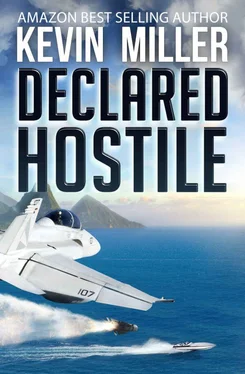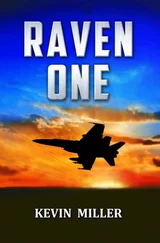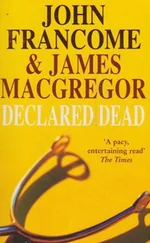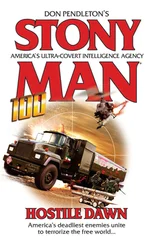Their work done for the moment, the bow catapult crews wasted no time watching 301 recede from view. They “wrapped up” the bow and went below to take a quick break before the next evolution. Sailors removed their cranial helmets as relative quiet returned to the flight deck, but abeam the island, a tractor chugged to life as it pulled a MH-60 Sierra from its parking spot nestled against the island. Another tractor pulled another Sierra from its spot. Once the helicopters were spotted on the waist, the crewmen spread their rotors. Eight SEALs emerged from the island and divided into two groups of four. One group entered the cabin of each aircraft as the pilots and aircrew prepared them for launch.
From his chair on the flag bridge, Devil Davies watched the SEALS go through their checks and contemplated his next move.
( Firebird 301, Western Atlantic)
Staying low on the water, Wilson lifted his Hornet skyward at seven miles off the bow. He then rolled left to join his wingmen on a prebriefed radial thirty miles in front of the ship. With his radar sweeping in range-while-search mode, he soon found the Slashes , three formations separated by altitude. Wilson’s formation of Firebirds was at fifteen thousand feet, Angels 15. As he leveled off to join on them, he picked them up as three dots on the gray horizon. Above he saw the other formations in their lazy turns, positioning to follow the lead gaggle at 15K once Wilson got aboard. The other package formations were to get to the tankers on their own.
In practiced motion, Wilson got on the left bearing line of the lead Hornet . While maintaining altitude and airspeed, he slid closer and closer using radius of turn. He soon saw that he was joining on Stretch who had DCAG and Dusty on his wing. Wilson eased up the bearing line as Stretch watched him. Once stabilized on his left side, Wilson added power and, through hand signals, took the lead from Stretch. Rolling out of his turn, Wilson steadied the formation on a heading of 180 to rendezvous on the tankers 150 miles ahead. Dusty slid under and joined on Wilson’s left wing in silence. Craning his neck right and left, Wilson saw the other two Slash formations high and behind. He added power to climb to the briefed rendezvous altitude of 25,000 feet.
Good.
The weather had become a major factor. They faced a high overcast with convective buildups and squalls scattered about. Wilson weaved his formation through ragged layers of broken clouds, and on his radar he could pick out the returns of small isolated rain clouds below them. The sun, a soft light behind the gray, was low to the west. It would sink below the horizon in an hour, but, with the cloud cover overhead, darkness would approach much earlier. They would join on the tankers during “daylight” but would not complete fueling until after the sun had set.
Below the American formations, merchant ships ploughed through powerful waves as they lumbered north and east toward Europe. With the high overcast, alert lookouts on the vessels could see the specks of fighters heading south in V formations, unusual on the open ocean. If anyone on a ship’s bridge was so inclined, a satellite phone call could report them. Wilson noted the time: an hour and twenty minutes to go. He figured the chance of a merchant sailor even being on a weather deck outside, much less looking out for anything, had to be remote.
Fuel. All carrier pilots obsessed over it, and the aviators took repeated glances at their fuel states, monitoring their engines and fuel flow and groundspeed against prefigured fuel “ladders” that served as checkpoints to gauge where their fuel levels “should” be. As last off, Wilson was “ahead” on fuel by a few hundred pounds, equal to a few minutes at his current airspeed. Ahead of all the carrier jets were the two Shell tankers. The fighters were scheduled for two — and by the end of the night, maybe three— stabs at a basket to take fuel in an effort to remain aloft for nearly five hours. He still couldn’t believe he had seen them from the flight deck and was reminded that anyone on any vessel below them could also see them. The radio crackled.
“ Slash one-one, Condor. Shell is on station at your one-seven-five for ninety.”
“Roger, Condor , looking,” Wilson transmitted on strike common frequency as he acknowledged the E-2 vectors.
“Roger. Blockers and Volts are about fifty miles in front of you.”
“Roger, Condor , thanks,” Wilson answered his shipmate monitoring a radar screen in the E-2.
With the big wing tankers on station, Wilson and the Slash formations would join on them in 10–15 minutes. They were in no rush as, by design, the Blockers, Volts and Lances plugged in first, aided by the FA-18E hose multipliers. Each KC-10 had refueling pods on the wings for a total of four hoses, and the Rhino tankers, call sign Arco , were probably on them now to fill up in order to transfer gas to the strike package aircraft once they showed up. The orchestration of flowing fuel across eight hoses to some thirty strike aircraft — in tight formations four miles up at 300 knots — was a huge timing and logistics challenge with many fallout plan contingencies. Carrier Air Wing SIX was going to do it twice in less than ideal weather conditions, and the second time at night. It was on the tanker things sometimes went to worms, and Wilson had to be ready to flex to plan B, C, or D with no notice. As strike lead, it was his call.
Wilson’s tanker was Shell 02, stepped up above and behind Shell 01 at 24,000 feet. Inside forty miles, he locked it and, aided by his targeting FLIR, could see the specks of four Blockers refueling on one of them. Each fighter was fragged to receive 6,000 pounds upfront and 6,000 on the backside once the strike was complete. Wilson watched the rendezvous geometry build on his radar and counted the little dots around the larger aircraft, his eyes scanning the horizon for unseen traffic. He entered the circle with care so as not to run into wayward aircraft joining on the wrong tanker.
Wilson held an easy left turn as Shell 02 flew five miles in front of him with the four Blockers and the two Volts in tow. Smooth on the stick, he maneuvered onto the bearing line and glided his three wingmen closer. In trail, one of the Arco FA-18E tankers had a Rhino plugged in and receiving. Below, the rest of the Slashes were joining on Shell 01. Three dozen aircraft were in tight quarters, all within 1,000 feet of each other, as the KC-10 pilots did their best to avoid broken cloud layers and scattered buildups. Sliding closer and closer to the Rhinos waiting in line, Wilson thought of the time and fuel and sunlight. And of San Ramón, two hundred miles away.
Fueling complete, the Blockers and Volts slid away from the KC-10 and soon disappeared to take a holding position. The Slashes eased, two at a time, behind the black rubber hoses trailing from the pods, one on each wing. The gray KC-10 was a big airplane, and Wilson noted McGUIRE painted in yellow letters over a blue band on top of the vertical tail. Jersey boys, and maybe girls, were inside the tanker. Painted on the nose of the aircraft he saw nose art that resembled graffiti found on a Camden railroad car. On closer inspection, Wilson read WAR LORD.
Gliding as one, the aircraft took their turns on the baskets, with Wilson crossing under to the right and Dusty taking position behind the hose on the left wing. They extended their refueling probes into the slipstream to their right and stabilized behind the baskets that were bouncing a bit in the turbulent air. The pilots added power to “plug” them and push the hose forward as a green light on the store indicated good flow. Despite being up a common frequency, nothing was said as the aircraft plugged in order. Wilson took glances at the formations all about him. He was on time line as he waited for his wingmen to take on fuel. The tanker occasionally popped through wisps of cloud it could not avoid, but the KC-10 pilots held steady while receiver jets were on their baskets. Thirty jets coming back here at night is going to be varsity. Wilson put the thought behind him.
Читать дальше












